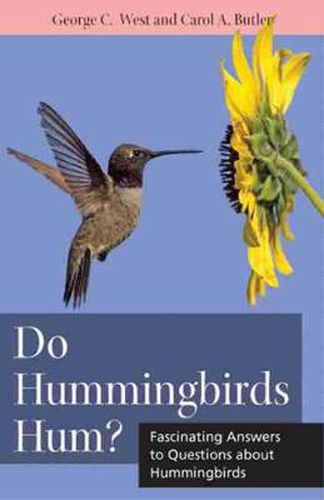Readings Newsletter
Become a Readings Member to make your shopping experience even easier.
Sign in or sign up for free!
You’re not far away from qualifying for FREE standard shipping within Australia
You’ve qualified for FREE standard shipping within Australia
The cart is loading…






Imagine a creature the size of your thumb, weighing less than a penny, but consuming half of its weight in food each day…Hummingbirds may be the smallest birds in the world, but they have the biggest appetites. Their wings flutter on average fifty to eighty times each second as they visit hundreds of flowers over the course of a day to sip the sweet nectar that sustains them. Their hearts beat nearly twelve hundred times a minute and their rapid breathing allows these amazing birds to sustain their unique manner of flight. They can hover in the air for prolonged periods, fly backwards using forceful wings that swivel at the shoulder, and dive at nearly two hundred miles per hour. Native only to the Americas, some hummingbirds have been known to migrate from Mexico to Alaska in the course of a season. Watching a hummingbird at a backyard feeder, we only see its glittering iridescent plumage and its long, narrow beak; its rapidly moving wings are a blur to our eyes.
These tiny, colorful birds have long fascinated birders, amateur naturalists, and gardeners. But, do they really hum?
In Do Hummingbirds Hum? George C. West, who has studied and banded over 13,500 hummingbirds in Arizona, and Carol A. Butler provide an overview of hummingbird biology for the general reader, and more detailed discussions of their morphology and behavior for those who want to fly beyond the basics. Enriched with beautiful and rare photography, including a section in vivid color, this engaging question and answer guide offers readers a wide range of information about these glorious pollinators as well as tips for attracting, photographing, and observing hummingbirds in the wild or in captivity.
$9.00 standard shipping within Australia
FREE standard shipping within Australia for orders over $100.00
Express & International shipping calculated at checkout
Imagine a creature the size of your thumb, weighing less than a penny, but consuming half of its weight in food each day…Hummingbirds may be the smallest birds in the world, but they have the biggest appetites. Their wings flutter on average fifty to eighty times each second as they visit hundreds of flowers over the course of a day to sip the sweet nectar that sustains them. Their hearts beat nearly twelve hundred times a minute and their rapid breathing allows these amazing birds to sustain their unique manner of flight. They can hover in the air for prolonged periods, fly backwards using forceful wings that swivel at the shoulder, and dive at nearly two hundred miles per hour. Native only to the Americas, some hummingbirds have been known to migrate from Mexico to Alaska in the course of a season. Watching a hummingbird at a backyard feeder, we only see its glittering iridescent plumage and its long, narrow beak; its rapidly moving wings are a blur to our eyes.
These tiny, colorful birds have long fascinated birders, amateur naturalists, and gardeners. But, do they really hum?
In Do Hummingbirds Hum? George C. West, who has studied and banded over 13,500 hummingbirds in Arizona, and Carol A. Butler provide an overview of hummingbird biology for the general reader, and more detailed discussions of their morphology and behavior for those who want to fly beyond the basics. Enriched with beautiful and rare photography, including a section in vivid color, this engaging question and answer guide offers readers a wide range of information about these glorious pollinators as well as tips for attracting, photographing, and observing hummingbirds in the wild or in captivity.